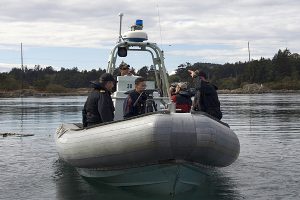Navy steps up whale protection policy
By Lookout on Oct 04, 2017 with Comments 0

Members of the media are escorted by RHIB (Rigid-Hulled Inflatable Boat) to Bentinck Island for a demolition demonstration on Sept. 20. Photos by Peter Mallett, Lookout
Peter Mallett, Staff Writer ~
When the Royal Canadian Navy (RCN) showed local media its Marine Mammal Mitigation Strategy on Bentinck Island Demolition Range it didn’t anticipate that whales would play a role in the demonstration.
As media watched navy personnel set up demonstration demolition charges two weeks ago, they were alerted to a pod of killer whales and a group of baleen whales by on-the-water sentries whose job it is to search out marine life near the island.
“The presence of so many whales were a surprise, but they appropriately demonstrated how our procedures play out in real life because whales do frequent the area on a regular basis,” said Duane Freeman, Senior Environment Officer with the RCN’s Formation Safety and Environment office. “We had to delay our demonstration, and in a worst-case scenario had they stayed in the area, we wouldn’t have done the demonstration at all.”
The day-long event was arranged to show local media what goes on at the demolition range and the steps the military takes to mitigate any harmful effects on surrounding marine life.
Regulations for activities on the property, located at the southwest corner of Rocky Point Ammunition Depot, include reductions in the amount of explosives used for detonations, a more restrictive explosives policy when whales are sighted in the area, and an expansion of safety zones.
The demonstration and strengthened policy come in the wake of concerns by the Pacific Whale Watching Association and tour boat operators in August that the use of explosives was harming a pod of killer whales in the vicinity.
A recent meeting between the base and the whale watching association resulted in agreed improvements such as halting explosives training when aquatic mammals are sighted within a two kilometres radius of the detonation site, an increase from the previous one kilometre; limiting explosives used from 2.25 kg to 1.13 kilograms; increased scrutiny of the surrounding area by the navy’s waterborne sentries; and better communication between sentries, whale watching boats, and the Range Safety Officer when whales are spotted.
Freeman says the new measures further enhance safety precautions and are designed to reduce the chance that whales and other marine mammals could be harmed by the explosions.
“We know from scientific studies that have been conducted that the sound wave from explosions on land does not move through the water, but what we have done is expand our safety template, specifically when we see whales out at sea,” said Freeman. “The key thing about revisiting our policies is to ensure the sustainability of the range and the immediate environment and ecosystem around us so the navy can continue to train.”
The demolition range at Bentinck Island has been in operation since 1953 and is near Race Rocks Provincial Ecological Reserve, which was established in 1980 as a Federal Marine Protection Area.
The navy has invited the Pacific Whale Watching Association for a similar demonstration later this year or in early 2018.
Filed Under: Top Stories
About the Author:





